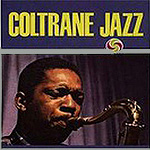 In jazz harmony, the Coltrane changes (Coltrane Matrix or cycle, also known as chromatic third
relations and multi-tonic changes) are a harmonic progression variation using substitute chords over common
jazz chord progressions. These substitution patterns were first demonstrated by jazz musician
John Coltrane on the album Blue Train on the tunes "Lazy Bird" and "Moment's Notice".
In jazz harmony, the Coltrane changes (Coltrane Matrix or cycle, also known as chromatic third
relations and multi-tonic changes) are a harmonic progression variation using substitute chords over common
jazz chord progressions. These substitution patterns were first demonstrated by jazz musician
John Coltrane on the album Blue Train on the tunes "Lazy Bird" and "Moment's Notice".
| GIANT STEPS Coltrane continued his explorations on the 1960 album “Giant Steps”, and expanded upon the substitution cycle in his compositions "Giant Steps" and "Countdown", the latter of which is a reharmonized version of Miles Davis's "Tune Up." The ability to solo over the Giant Steps/Coltrane cycle remains one of the standards by which a jazz musician's improvising ability is measured. |
|
| NAIMA "Naima" is a ballad composed by John Coltrane in 1959 that he named after his wife, Juanita Naima Grubbs. It first appeared on the album Giant Steps and is notable for its use of a variety of rich chords over a bass pedal. It is mainly made up of a slow, restrained melody, though there is also a brief piano solo. Coltrane recorded "Naima" many times. It appears on The Complete 1961 Village Vanguard Recordings, The Complete Copenhagen Concert, Afro-Blue Impressions, and Live at the Village Vanguard Again!. "Naima" has since become a jazz standard. Chord changes for "Naima": ?: B?–7/E? | E?–7 | Amaj7+5/E? Gmaj7+5/E? | A?maj7/E? :? ? Bmaj7/B? | B?7?9 | Bmaj7/B? | B?7?9 | | B-maj7/B? | Bmaj7/B? | A?maj7/B? | Emaj7?4 ? ? B?–7/E? | E?–7 | Amaj7+5/E? Gmaj7+5/E? | A?maj7/E? ? |
|
| MY FAVORITE THINGS is the seventh studio album by jazz musician John Coltrane, released in 1961 on Atlantic Records, catalogue SD-1361. It was the first album to feature Coltrane playing soprano saxophone. An edited version of the title track became a hit single that gained popularity in 1961 on radio. The record became a major commercial success. In 1998, the album received the Grammy Hall of Fame award. |
|
| BLUE TRANE “Blue Train” is the best thing that could have possibly come out of Coltrane’s first attempt at leading and composing his own group. His later works such as “Giant Steps” and “A Love Supreme” may be well-known, but this album is on the same scale if not greater considering his inexperience as a leader and a composer. Its influence on jazz is extraordinary. This band’s and this album’s sound is different from most of jazz and revolutionary and the title track is commonly used as an audition piece. Highly recommended for anyone who even remotely likes jazz. ~Sputnik Music |
The changes serve as a pattern of chord substitutio ns for the ii-V-I progression (supertonic-dominant-tonic) and are noted for the tonally unusual root movement down by major thirds (as opposed to the usual minor or major seconds, see steps and skips, thus the "giant steps"), creating an augmented triad.
Miles Davis, who mentored Coltrane in many ways, was in the late 1950s moving toward the modal style of Kind of Blue In playing that style, Coltrane found it, "easy to apply the harmonic ideas I had... I started experimenting because I was striving for more individual development. He developed his sheets of sound style while playing with Davis and with pianist Thelonious Monk during this period
Coltrane studied harmony at the Granoff School of Music in Philadelphia, exploring contemporary techniques and theory. He also spent much time studying the Thesaurus of Scale and Melodic Patterns by Nicolas Slonimsky (1947), which additionally served as practice material. The first half of Giant Steps (melody and harmony) is contained in the Preface of Slonimsky's book.
The bridge of the Rodgers and Hart song and jazz standard "Have You Met Miss Jones?" (1937) predated Tadd Dameron's "Lady Bird", after which Coltrane named his "Lazy Bird", by incorporating modulation by major third(s) (shown by the * below) "Giant Steps" and "Countdown" may both have taken the inspiration for their augmented tonal cycles from "Have You Met Miss Jones".
To Do:
 Play and study the 8-bar bridge segment from this tune from the “Great American songbook” period, “Have You Met Miss Jones”.
Play and study the 8-bar bridge segment from this tune from the “Great American songbook” period, “Have You Met Miss Jones”.Notice the unusual-for its time-cyclic thirds chord changes within the body of the bridge. The harmonic structure of this piece by Rodgers and Hart (1937) predated Coltrane’s use of cyclic thirds by many years.
